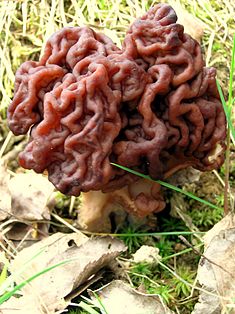We need you! Join our contributor community and become a WikEM editor through our open and transparent promotion process.
Gyromitra mushrooms
From WikEM
(Redirected from Gyromitra)
Contents
Background
- Also known as "brain fungi"
- Fruit in the spring and early summer
- Frequently mistaken for morel mushrooms[1]
- Inhibits formation of Vitamin B6 and GABA via hydrazine metabolite
Clinical Features
- GI upset, fatigue, muscle cramps
- Liver failure
- Hypoglycemia
- Rhabdomyolysis
- Can present with refractory seizures due to GABA deficiency
- Hemolysis usually mild
- Rarely methemoglobinemia
Differential Diagnosis
Mushroom toxicity by Type
| Mushroom | Toxin | Pathologic Effect |
| Amanita | Amatoxin | Hepatotoxicity |
| Coprine | Disulfiram-like | |
| Crotinarius | Orellanine | Delayed renal failure |
| Gyromitra | Gyromitrin | Seizures |
| Ibotenic Acid | Anticholinergic | |
| Muscarine | Cholinergic | |
| Orellanin | Nephrotoxicity | |
| Psilocybin | Hallucinations |
Evaluation
Workup[2]
- Blood sugar
- BMP
- LFT
- Coags
- CBC with differential
- LDH, haptoglobin, reticulocyte
- CK
- MetHb level
- Urine drug screen
- Urinalysis
Management[3]
- Supportive care
- Dextrose boluses/infusions
- High dose pyridoxine for refractory seizures (5g IV initially) [4]
- Avoid phenobarbital, especially in liver failure
- Methylene blue for severe methemoglobinemia
- Folinic acid supplementation (hydrazines inhibit MTHF production)
- Liver transplant for refractory hepatic failure
Disposition
See Also
References
- ↑ Brozen R et al. Gyromitra Mushroom Toxicity. Apr 14, 2015. http://emedicine.medscape.com/article/817931-treatment#showall.
- ↑ Tomková J, Ondra P, Válka I. Simultaneous determination of mushroom toxins α-amanitin, β-amanitin and muscarine in human urine by solid-phase extraction and ultra-high-performance liquid chromatography coupled with ultra-high-resolution TOF mass spectrometry. Forensic Sci Int. 2015 Jun. 251:209-13.
- ↑ Diaz JH. Syndromic diagnosis and management of confirmed mushroom poisonings. Crit Care Med. 2005 Feb. 33(2):427-36.
- ↑ Berger KJ, Guss DA. Mycotoxins revisited: Part II. J Emerg Med. 2005;28(2):175.

